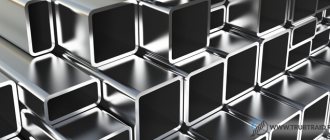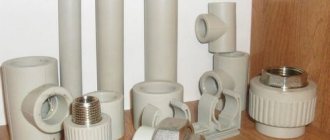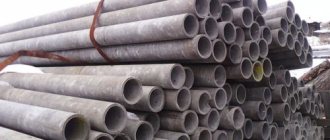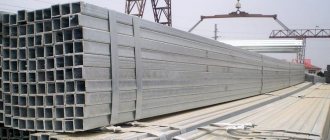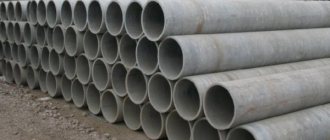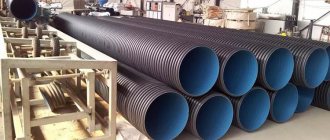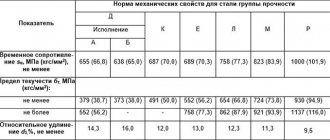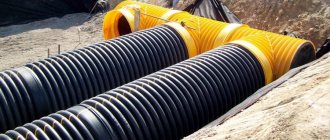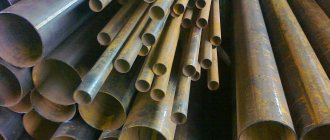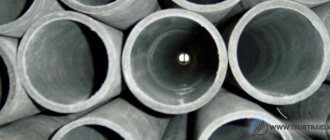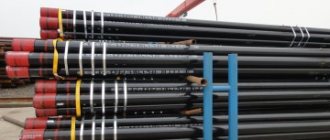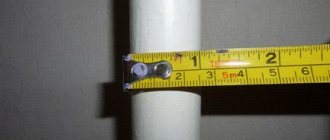Welded square pipe, a varied assortment of which allows you to select a product with the required geometric parameters, is produced according to the requirements contained in GOST 30245-2003. Replacing the outdated GOST 30245-94, this regulatory document defines the requirements for the range and geometric parameters of not only square, but also profile rectangular pipes, also classified as welded.
Square steel pipe
Application area
This standard applies to steel bent closed welded square and rectangular sections intended for structural steel structures.
Profiles are manufactured on specialized mills by forming a round tubular section with a longitudinal weld and subsequent compression by rollers into a square or rectangular profile.
Mandatory product quality requirements are set out in paragraphs 3.3 - 3.6, 4.3 - 4.5, 4.7, 4.11, 4.12, 5.2, 5.4, 5.5, 5.8 - 5.10, 5.12.
How to understand the markings
The marking of square steel pipes, the requirements for which are also specified in GOST, reflects the following characteristics.
At the top of the marking (numerator):
- geometric parameters of the products of the marked batch (height, width, wall thickness);
- number of the regulatory document in accordance with which the product is manufactured.
At the bottom of the marking (denominator):
- grade of steel from which the profile pipe is made;
- number of the regulatory document to which the material of manufacture of the product corresponds.
Marking of square pipes contains information about product parameters
As an example, let's look at how a square-section profile pipe with side dimensions of 100 mm and a wall thickness of 6 mm, made of S390K steel, is marked:
100x100x5 GOST 30245-2003/S390K GOST 2772-88.
Normative references
This standard uses references to the following standards:
GOST 166-89 Calipers. Specifications
GOST 427-75 Metal measuring rulers. Technical specifications GOST 1050-88 Long rolled products, calibrated, with special surface finishing, made of high-quality carbon structural steel. General technical conditions
GOST 3242-79 Welded joints. Quality control methods GOST 5264-80 Manual arc welding. Welded connections. Main types, structural elements and dimensions
GOST 5378-88 Protractors with vernier. Technical specifications GOST 7502-98 Metal measuring tapes. Technical specifications GOST 7566-94 Metal products. Reception, labeling, packaging, transportation and storage
GOST 8713-79 Submerged arc welding. Welded connections. Main types, structural elements and dimensions
GOST 14637-89 Rolled thick sheets of carbon steel of ordinary quality. Specifications
GOST 15150-69 Machines, instruments and other technical products. Versions for different climatic regions. Categories, operating, storage and transportation conditions regarding the impact of environmental climatic factors
GOST 16523-97 Rolled thin-sheet carbon steel of high quality and ordinary quality for general purposes. Specifications
GOST 17066-94 Rolled thin sheets of high strength steel. Specifications
GOST 19281-89 Rolled products from high-strength steel. General technical conditions
GOST 19903-74 Hot-rolled sheet products. Assortment
GOST 27772-88 Rolled products for building steel structures. General technical conditions
Assortment
3.1 The cross-section of the profiles must correspond to that shown in Figure 1.
3.2 Profile dimensions, cross-sectional area, reference values for axes and weight for 1 m of profile must correspond to: for square profiles - table 1; for rectangular profiles - table 2.
Figure 1. h - height; b—width; t—wall thickness; R - radius of external curvature
3.3 Maximum deviations in the thickness of the wall of the profiles must correspond to the maximum deviations in the thickness of the initial workpiece with a width of 1250 mm of normal rolling accuracy B according to GOST 19903. Maximum deviations in thickness do not apply to bending areas.
3.4 Maximum deviations in height and width of the profile must correspond, %:
with a profile height (width) of up to 100 mm - ±1.0, but not less than ±0.5 mm;
»»»» St. 100 mm - ±0.8.
3.5 Tolerances for external rounding radii must comply with:
at t
at 6.0
at t > 10.0 mm - from 2.4t to 3.6t.
3.6 In the cross section of the profile, deviations from an angle of 90° should not exceed ±1°30′.
3.7 Profiles are made with lengths from 6.0 to 12.0 m, and by agreement between the consumer and the manufacturer - with lengths from 4.0 to 13.0 m:
- unmeasured length;
— measured length;
— a multiple of the measured length.
3.8 Maximum deviations along the length of profiles of measured and multiple measured lengths should not be more than +60.0 mm.
3.9 An example of a symbol for a bent welded profile with a height of 180, a width of 100, a wall thickness of 5 mm, made of steel C245 according to GOST 27772:
Table 1.
Table 2.
Notes on tables 1 and 2
1 I—moment of inertia; W is the moment of resistance; i is the radius of gyration.
2 Radius of external corner rounding R = 2.0/ at t 10.0 mm.
3 The mass of 1 m of profile length is determined by the cross-sectional area, with a steel density of 7.85 g/cm3.
4 By agreement between the consumer and the manufacturer, it is possible to produce profiles of other sizes.
Production of square profile pipes according to GOST
GOST 30245-2003 is an official regulatory document that specifies not only the dimensions of square pipes, but also the technological features of their production. Naturally, profile pipes that are produced by handicraft methods are strictly prohibited from being used in capital construction. Such products most often do not comply with GOST requirements not only in terms of geometric parameters, but also in terms of strength characteristics. In addition, they are not marked and are not considered goods admitted for public sale.
Line for the production of profile pipes
Technical requirements
4.1 Profiles are manufactured in accordance with the requirements of this standard according to technological regulations approved in the prescribed manner.
4.2 Profiles should be made from rolled sheets supplied in rolls according to GOST 19903, from steel:
— carbon general purpose and low-alloy with a thickness of 3 mm or more — according to GOST 27772;
- carbon general purpose with a thickness of 4 mm and more - according to GOST 14637; with a thickness of 3 mm - according to GOST 16523;
— carbon quality grades 10, 15 and 20 — according to GOST 1050;
— low-alloy thickness of 4 mm or more — according to GOST 19281; 3 mm thick - according to GOST 17066.
The steel grade and delivery category are indicated in the order for profiles.
4.3 Local curvature of profiles in the horizontal and vertical planes should not exceed 1 mm per 1 m of profile length.
The total curvature should not exceed the product of the permissible local curvature (per 1 m of length) and the length of the profile in meters.
4.4 Twisting of profiles around the longitudinal axis should not exceed 2.0 mm plus 0.5 mm per meter of profile length.
4.5 The convexity and concavity of the profile walls should not exceed 0.01 of the profile size.
4.6 Profiles must be cut at right angles. Deviation from the perpendicularity of the cutting plane to the profile axis should not cause the profile to have abnormal length dimensions.
Fire trimming of the ends of individual profiles is allowed in an amount of no more than 7% of the batch weight.
4.7 Cracks, sunsets, deep risks and other damage to the surface of profiles are not allowed. Minor roughness, nicks, dents, small scratches, a thin layer of scale and individual hairs should not interfere with the detection of surface defects and bring the wall thickness of the cross-section of the profile beyond the limits of permissible deviations.
4.8 Burrs on the ends of the profiles must be removed mechanically at the request of the customer.
4.9 The longitudinal weld is performed by automatic high-frequency welding, and it must be located at a distance from the edge of the profile no closer than 4t.
4.10 The bead from the longitudinal seam is removed from the outer side of the profile, and the height of the bead protruding above the surface of the profile should not exceed:
— for profile wall thickness up to 4 mm — 0.5 mm;
- """" more than 4 mm - 1.0 mm.
4.11 Lack of penetration (lack of fusion) of the longitudinal seam should not exceed 50 mm per 1 m of profile length. The length of an individual local lack of penetration should not be more than 20 mm.
Defective areas must be corrected using manual or semi-automatic welding in accordance with GOST 5264 and GOST 8713 using welding and filler materials that correspond to the mechanical properties of the profile steel. After correction, the seams must be cleaned.
4.12 The tensile strength of the longitudinal weld must be no less than 0.95 of the tensile strength of the base metal.
Side dimensions and wall thickness of a square pipe
According to GOST requirements, the dimensions of the sides of profile pipes with a square cross-section can vary in the range of 50–300 mm. In the range of these products, each profile size corresponds to a certain wall thickness: the larger the dimensions of the sides of the steel square pipe, the greater the wall thickness (this parameter varies in the range of 2–14 mm) they are produced.
All parameters that square pipes must comply with are given in the table.
Basic parameters of square pipes
Steel profile pipes with a square cross-section can be produced not only according to GOST, but also according to TU - these are specially developed Technical Conditions. In accordance with the requirements of this document, which is approved by the state regulatory body, pipes with a square profile can be produced in non-standard sizes (length, wall dimensions and thickness). Such products, the marking of which contains the abbreviation TU, are produced mainly on special orders.
When reviewing and approving the Technical Specifications, the state regulatory body assesses the degree of safety of products with non-standard sizes, provides for their mandatory testing, and also determines whether it is possible to produce it on the equipment with which the enterprise is equipped.
4.13. Completeness
4.13.1 The delivery set includes: profiles packed in packs according to standard batch sizes, and a quality document.
4.13.2 The quality document must contain the following data:
— name of the manufacturer or its trademark;
— name of the consumer;
— profile designation;
- heat number, chemical composition and mechanical properties of steel (according to the quality document with the quality control department stamp of the plant - supplier of sheet rolled coils);
— profile length;
— number of packs;
— number of profiles;
— order number and quality control stamp;
— date of execution of the quality document.
4.14. Package
4.14.1 Profiles are bundled in accordance with the requirements of GOST 7566.
The profiles in the bundle must be tightly laid and tightly tied in the transverse direction every 2 - 3 m of length.
Profiles in a bundle up to 6 m long inclusive must be tied in at least two places.
Profiles are supplied by theoretical weight.
Package weight: no more than 10 tons.
4.14.2 Packaging of profiles in bundles must ensure the ability to carry out loading and unloading operations using lifting mechanisms without damaging the profiles and in compliance with safety measures.
GOST 8639-82 requirements for profile pipes
In accordance with the rules of GOST 8639-82, square profile pipe can be of the following types:
- seamless hot-deformed steel;
- cold-deformed seamless steel;
- electric welded;
- electric-welded cold-deformed.
The dimensions and shape of profile pipes are indicated in the table attached to the above GOST.
The dependence of the method of manufacturing profile pipes on the dimensions of the product is as follows:
- cold-deformed pipes are made, the length of the side of the profile ranges from 10-120 mm, and the wall thickness is 1-8 mm;
- the hot-deformed method produces pipes with a profile side length of 60-180 mm and a pipe wall thickness of 4-14 mm;
- Accordingly, electric-welded pipes are made with external dimensions of 10-100 mm and wall thickness of 1-5 mm.
According to this GOST, the profile pipe must have a radius of curvature not exceeding 2s. However, upon agreement with the consumer, the manufacturer must provide for the rounding of manufactured pipes no higher than 1.5s, and for profile electric-welded pipes 60*60*4 mm - no higher than 3s.
GOST table: profile steel pipes 8639-82
Square profile pipe GOST 8639-82 is produced according to the following length regulations:
- measured length:
- seamless cold-deformed - 4.5-11 m long;
- seamless hot-deformed – 4-12.5 m long;
- electric welded - 5-9 m long.
The permissible maximum deviation for the entire length of the profile pipe is +100 mm.
- unmeasured length:
- electric-welded and seamless cold-deformed - 1.5-9 m long;
- seamless hot-deformed – 4-12.5 m long.
- length multiple measured:
- seamless cold-deformed pipes – 1.5-11 m long with a 5 mm allowance for each cut;
- seamless hot-deformed - 4-12.5 m long with an allowance of 5 mm for each cut;
- electric welded pipes - any expansion that does not exceed the lower limit established for measuring pipes.
The total length of multiple pipes should not be higher than the upper limit for measuring pipes. For each multiple, the allowance is set at 5 mm (or an allowance of a different size agreed with the customer) and is included in all ordered multiples.
Provided tolerances:
- According to this GOST, profile pipes must have maximum deviations in concavity of the sides, wall thickness, external dimensions, not exceeding the values specified in the table attached to GOST.
- In the cross sections of profile pipes, deviation from the right angle is not allowed by more than ±1.5 degrees.
- Curvature of pipes exceeding for each m.p. is not allowed. length value is 2 mm.
Advice!
By agreement with the customer, pipes can be manufactured without straightening. Norms for curvature are not regulated.
According to technical requirements, among other things, profile pipes must comply with GOST 13663.
Acceptance rules and control methods
5.1 Profiles are accepted in batches. A batch is considered to be profiles of the same profile size and one grade of steel, accompanied by one quality document. The number of profiles in a batch should be no more than 200 pieces.
5.2 If there is automatic control of welding of the longitudinal seam, 3% of the profiles from the batch are subject to inspection of the external appearance.
In the absence of automatic control, the profiles are subjected to continuous control in accordance with GOST 3242.
5.3 When checking the surface quality of profiles, a batch is considered to comply with the requirements of this standard if the mass of profiles with an unsatisfactory surface does not exceed 3% of the mass of the batch.
5.4 Sections of profiles with transverse seams must be cut out and discarded. Welding of profile transverse seams by semi-automatic welding is allowed, provided that the weld is equal in strength to the base metal. The joint must be marked with indelible paint.
5.5 Dimensions that have maximum deviations must be checked on profiles selected every 1000 m of profiling.
5.6 If, when checking the selected profiles, there is at least one that does not meet the requirements of this standard, you should select twice the number of profiles from the same batch and re-check them.
If the results of the re-inspection are unsatisfactory, piece-by-piece inspection is carried out.
5.7 The brand, chemical composition and mechanical properties of the profile material must be certified by a document on the quality of the enterprise - supplier of sheet metal in rolls.
5.8 Geometric dimensions are checked during operational control with a metal measuring ruler in accordance with GOST 427, an MTs-3 caliper in accordance with GOST 166, a radius template, an angular template, an inclinometer in accordance with GOST 5378. The length of the profiles
measured with a tape measure RZ-20 according to GOST 7502.
The geometric dimensions of the profile section are checked at a distance of at least the larger section size from the end of the profile.
It is allowed to replace the specified measuring instruments with others, similar in purpose, with an accuracy class not lower than those provided for by the specified standards.
5.9 Local curvature is measured with a metal ruler in accordance with GOST 427. The general curvature of the profile is measured using a string stretched across the ends of the profile and a ruler.
5.10 Twisting and deviation from perpendicularity of the cutting plane of profiles is determined by an inclinometer according to GOST 5378.
5.11 The quality of profile cutting is checked by external inspection.
5.12 Welds are controlled in accordance with GOST 3242 without testing for tightness.
5.13 Completeness is checked by comparing the batch of profiles prepared for shipment with the work order.
5.14 Packaging and marking of profiles is checked by external inspection for compliance with the requirements of this standard.
Performance characteristics and applications of square pipes
The performance characteristics of steel pipes with a square profile are determined both by the material of their manufacture and by the features of their design, which is a closed profile formed from a metal strip. The result is a pipe that is lightweight but can withstand significant bending and torsion loads. The requirements for its strength characteristics, as well as the test methods by which they are controlled, are also specified in GOST.
Profile pipes are often used in load-bearing frames of various structures
Due to their exceptional strength characteristics, low weight and manufacturability, profiled metal pipes with a square cross-section have found wide application in many branches of human activity. So, these products are most actively used for:
- construction of buildings for various purposes (such pipes are used to construct lightweight load-bearing structures for warehouses, shops, greenhouses, winter gardens, farms, sheds, etc.);
- reconstruction of construction sites (with the help of square steel pipes, frames of roofing structures and ceilings, entrance lobbies, etc. are created);
- furniture production (cabinets, racks, shelves, tables, chairs, etc.);
- production of various mechanisms and devices in mechanical engineering;
- creation and installation of advertising structures.
Unlike pipes with a round cross-section, which, when exposed to significant bending loads, can not only bend but also collapse, products with a square profile under the same value and direction of the load only bend, and when it is removed they return to their original state.
When choosing a square profile pipe to solve a specific problem, you must first make all the necessary calculations. As a result, it will become clear which product with what geometric profile parameters will be able to withstand the loads that will fall on it.
